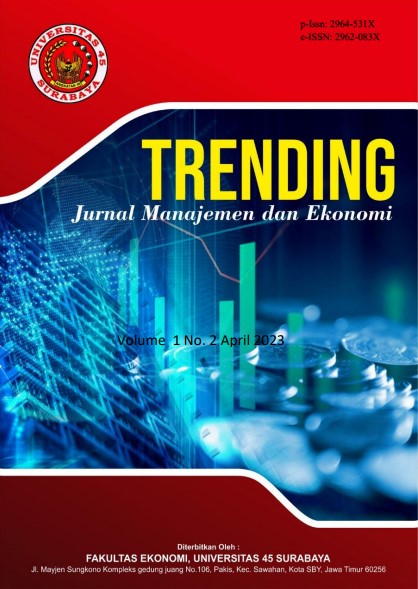Strategi Pengembangan Koperasi dalam Mengangkat Kesejahteraan Kesejahteraan Masyarakat
DOI:
https://doi.org/10.30640/trending.v3i1.3739Keywords:
development strategy, cooperatives, community economic welfareAbstract
The purpose of this Observation is to identify and evaluate external and internal elements and cooperative development tactics that can improve the welfare of the people of Tulungagung Regency. The methodology used in this Observation is qualitative. In-depth interviews, focus group discussions, observation, and documentation are the methods used to collect data. SWOT analysis is the data analysis method used. Referring to the Observation findings, the researcher came to the following conclusions: The results of the Observation reveal that the approaches that can be taken to build cooperatives and improve the welfare of the people's welfare are: One way to develop the people's economy is by: Utilizing the APBN to provide funding stimulus for business funding for people's economic actors, increasing the number and quality of local products so that they are able to compete in regional and global markets, improving agricultural human resources through funding from financial institutions and private assistance (business partners). This can be done in order to overcome various obstacles in the development of the people's economy: Improving the quality of human resources of people's economic actors through non-formal teaching and practice, continuous teaching and practice for assistants, utilization of appropriate technology (TTG) for the provision of funding for agricultural businesses and equipment, expanding the role of MSMEs and cooperatives in all districts and cities, and utilization of activity funds for profitable economic businesses. Improving the quality and quantity of competitive local products can be done through policies to build a people's economy. In addition, the community rarely relies on government funding assistance, and economic actors rarely rely on middlemen. The IE Matrix Strategy is a strategy analysis used in the growth-driven strategy development model, while the SWOT diagram displays Quadrant I which reveals a favorable situation because cooperatives in the Kedungwaru Tulungagung Area have strengths and opportunities that allow them to maximize their potential and implement strategies that support aggressive growth policies.
References
Creswell, J. W. (2018). Research Design: qualitative, quantitative, and mixed methods approaches. Sage.
Haryanti, N. (2019). Metode Penelitian Ekonomi. Bandung: Manggu.
Ismail, M. (2015). Strategi Pengembangan Ekonomi Rakyat di Provinsi Papua. Jurnal Bina Praja, 07(03), 251–259. https://doi.org/10.21787/jbp.07.2015.251-259
Miles, matthew B., Huberman, A. M., & Saldana, J. (2014). Qualitative Data Analysis. New Delhi: SAGE Publications.
Pranata, S. (2024). Analisis Kredit CV. Usada Makmur Perkasa Mandiri untuk Meningkatkan Pendapatan Angota Koperasi. Jurnal Akuntansi, Manajemen Dan Ilmu Ekonomi (Jasmien), 5(02), 1–11.
Rahardjo, M. D. (2011). Koperasi Sukses Indonesia. Jurnal Maksipreneur: Manajemen, Koperasi, Dan Entrepreneurship, 1(1), 1. https://doi.org/10.30588/jmp.v1i1.61
Rangkuti, F. (2015). Analisis SWOT: Teknik Membedah Kasus Bisnis. Jakarta: PT Gramedia Pustaka Utama.
Ropke, J. (2013). Ekonomi Koperasi Teori dan Praktik. Jakarta: Salemba Empat.
Samantha, R., & Almalik, D. (2019). Strategi pengembangan Koperasi dalam Upaya Membangun Kesejahteraan Masyarakat. Derivatif: Jurnal Manajemen, 3(2), 58–66.
Setiowibowo, S., Kurniawan, E. B., & Fadly Usman. (2020). Hubungan Pembangunan Perumahan Terhadap Aspek Sosial Ekonomi Masyarakat Dan Lingkungan Permukiman Di Kelurahan Mlajah. Planning for Urban Region and Environment, 9(4), 131–142.
Sitio, A., & Tamba, H. (2011). Koperasi Teori dan Praktik. Jakarta: Erlangga.
Suparjan, & Suyatno, H. (2013). Pembangunan Masyarakat dari Pembangunan sampai Pemberdayaan. Yogyakarta: Aditya Media.
Wulandari, M., & Sulistari, E. (2018). Strategi Pengembangan Koperasi (Studi Kasus Pada Koperasi Simpan Pinjam Mentari Dana Mandiri Salatiga). UKSW Salatiga, 1, 1–6.
Downloads
Published
How to Cite
Issue
Section
License
Copyright (c) 2024 Trending: Jurnal Manajemen dan Ekonomi

This work is licensed under a Creative Commons Attribution-ShareAlike 4.0 International License.








